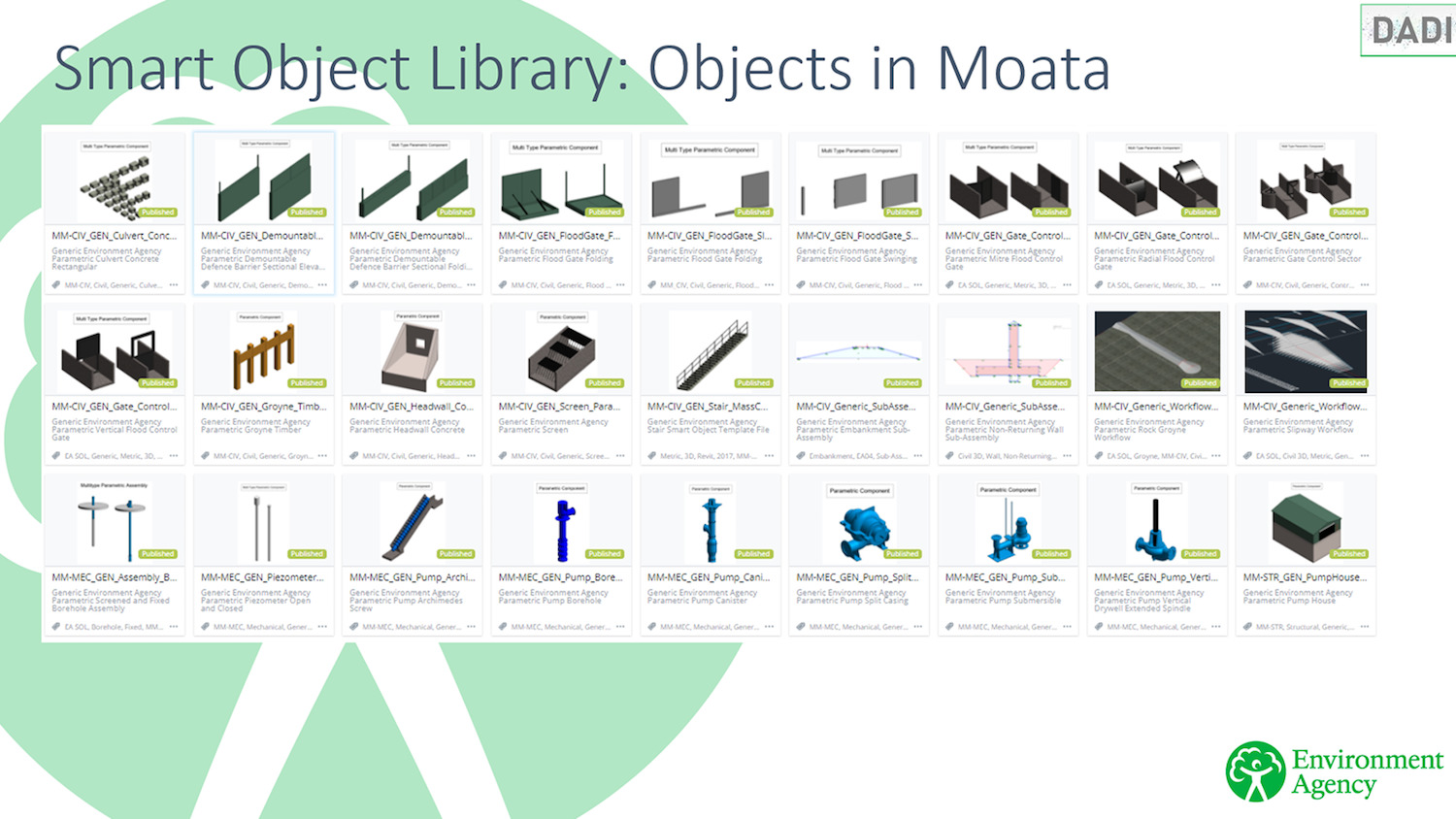
Inspired by Bentley Systems’ work with Mott MacDonald to produce a smart object library for the Environment Agency, Claire Rutkowski details the best practice and benefits of developing and using component-based design.
Facing high demand for infrastructure upgrades, the Environment Agency was searching for a consistent process to create and exchange digital information, including the reuse of existing designs. Mott MacDonald created a centralised library of parametric smart objects to support the reuse of design content using standard rules and formats. The result? Impressive environmental, financial and process-oriented benefits.
The component library provided better data for carbon calculators, and designs were able to achieve whole-life carbon and whole-life cost objectives. The library’s content reuse generated a three times return on investment in the first three months. That figure is expected to grow to 25 times ROI over two years.
Darren Russell, chief digital officer at Mott MacDonald, said: “Component reuse has saved a total of 158,000 project delivery hours. This equates to saving 21,000 days or 84 years of time.”

“It’s an easy way to harness your best work and reuse it over and over again. Your next project will be as good as your best project – every time.”
Creating a component centre or library that makes it easier to find and reuse designs can be a game changer. It’s an easy way to harness your best work and reuse it over and over again. Your next project will be as good as your best project – every time. But many firms are not fully realising component-based design’s efficiency and quality-related benefits. Here, I’ll briefly look at what component-based design is, what the benefits are, and then delve into how you can maximise the value of a component library.
What is component-based design?
Component-based design is not new. The Romans figured out their two or three best designs and used them repeatedly to build new cities and fortifications across their empire. After all, why reinvent the wheel every time?
Component-based design advanced over the last several decades in software engineering and website development. The concept uses ready-made and tested elements (components) as building blocks for your project. Once vetted and catalogued in a component library, there is no limit to the amount of reuse for a key component. It’s the ultimate in reuse and recycling, making it easier and faster to define and compose independent components into a complete system.
Component-based design for construction focuses on component reusability by breaking designs apart into smaller, reusable building blocks. Designers can then build designs more quickly and with less effort by starting with tried-and-true design components.
If you are building a road, your components might be streetlights, curbs, drainage ditches and manhole covers – anything that is repetitive and standard for street construction. Each component encapsulates the functionality, behaviours and dimensions of a self-contained, reusable object.
With these components easily in reach, you can simply cut and paste them into your design. Think of it as a library of templated building blocks that already hold the best practices and knowledge from the designers who created them, helping you capture and perpetuate their expertise and experience.
Benefits of component-based design
The benefits of component-based design are obvious. A digital component library can help eliminate repetitive design tasks, accelerate production timelines and increase deliverable quality. Component-based design allows you to:
- Increase throughput. A component library lets you access and reuse the best pre-built design components from across the firm. Design time is reduced from days to hours, resulting in significant time savings. Your firm can do more work with the same number of people.
- Improve quality. Because you are identifying, capturing, and reusing the best components – proven to work – and those that have institutional knowledge baked in, consistency and quality improve, enabling you to deliver better outcomes to your clients.
Creating a component library
“Once vetted and catalogued in a component library, there is no limit to the amount of reuse of a key component.”
A component library allows reuse of work you’ve already done for other clients. To optimise usage, the library needs to have intuitive search and flexible hierarchies to easily find the data.
The library should house reusable components and workflows that showcase the best practices from across your organisation and portfolio of projects. Library services should also help drive standardisation, automation and ultimately reuse of design objects.
Let’s say you focus on water treatment plants – you will need a components library that houses the best valve, pump and switch designs. Using these vetted, quality-checked components saves time and ensures quality results.
More than just a library
As with most other digital transformations, the technology is the easy part. The people and processes that support the new tool are equally important to success – and often harder to get right.
- People considerations. Think about how (and who) identifies the components. Who approves the designs? Who is the librarian? How will others in the organisation find what they need? Engineers tend to think that every project needs a unique, custom-built solution, and we pride ourselves on creating bespoke solutions. The reality is that we don’t have time for one-off solutions every time, nor are they always needed. Overlap and standardisation do exist among projects. Once designers and engineers can find and use the right component, they’ll be able to work on more designs in less time.
- Process considerations. The process side can be equally daunting, but once the library is up and running and everyone understands why it’s beneficial, users will begin to rely on it, saving time and money. You’ll need to consider how the components will be extracted from the original design and put into the library. How will components be catalogued? Firms with a successful component library – where components are easy to find, relevant, and stay refreshed – have seen a great return on their investment.
Changing the game
AEC firms need to embrace component-based design. It’s a game changer that maximises resources, focusing on reusing work to save time and complete more projects. As you reuse what works from successful projects, you will generate insights and share learnings. By embracing a component-centric approach, you’ll be on a path toward creating higher-quality and safer designs in less time.
Claire Rutkowski is SVP and CIO champion at Bentley Systems.
Don’t miss out on BIM and digital construction news: sign up to receive the BIMplus newsletter.











